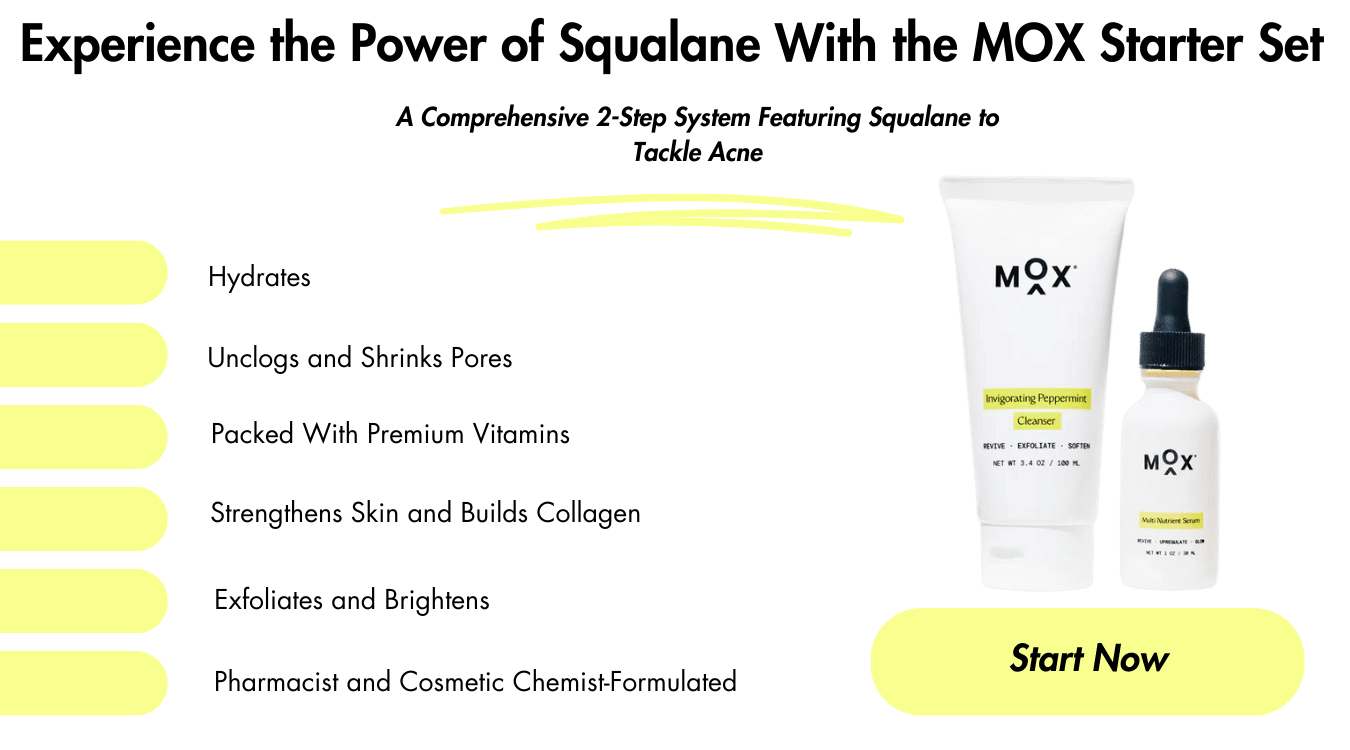Table of Contents:
- Is Squalane Comedogenic? Understanding Squalane for Acne
- Exploring Squalane for Acne: Is Squalane Comedogenic?
- The Difference Between Squalane and Squalene: What Is Squalane? Is Squalane Comedogenic?
- A Video Answering: What Is Squalane? Is Squalane Comedogenic?
- Is Squalane Comedogenic? What Can Squalane Do for Your Skin?
- Side Effects of Squalane for Acne: Are Squalane Breakouts Rare? Can It Be Used With Retinol?
- Is Squalane Comedogenic? It's Non-Comedogenic, So Try Products Formulated With Squalane for Acne

Give it to us straight – did you know your skin has a built-in moisturizing system known as squalene (with an e)? It works to strengthen your skin barrier and helps it to retain moisture. But – if you’ve noticed it being spelled like squalane (with an a) on some labels, you’re probably a bit confused, which is where MOX comes in.
To help you understand the difference between squalene and squalane (because it's confusing), let's explore two questions: Is squalane comedogenic? Should you try products with squalane for acne? Here is the need-to-know info from MOX experts:
Exploring Squalane for Acne: Is Squalane Comedogenic?

Is squalane comedogenic? Nope, it's non-comedogenic! In fact, using squalane for acne is nothing new as squalane’s comedogenic rating is 0-1, which means that it won’t clog your pores.
The reason why squalane's comedogenic rating is so important is that clogged pores can be a precursor to acne. By using squalane for acne and taking advantage of it being non-comedogenic, you can say goodbye to breakouts.
Using squalane for acne may balance your skin’s sebum levels (an annoying but useful oily substance that protects your skin). Squalane may also strengthen your skin's natural barrier function, reducing your risk of acne.
In addition, squalane’s comedogenic rating means it’s gentle and non-irritating. It can even be used with acne medications and/or treatments. Many use squalane for acne scars, too, as it can fade post-acne marks (more on this above).

The Difference Between Squalane and Squalene: What Is Squalane? Is Squalane Comedogenic?

Let’s start off with the squalene and squalane spelling debacle: Squalene, with an e, is an antioxidant that’s found naturally in your skin and – controversially – in shark liver. Similar to ingredients like vitamin C, squalene can protect your skin against pollution, weather, and other stress factors, but at what cost?

Even though squalene naturally occurs in your body, the amount it produces peaks in your teens and declines as you age. Squalene is also highly unstable, making its shelf life very short. This is one reason that many skincare brands formulate with squalane (notice the a?).
As for the question of "What is squalane?", it’s the more stable and lighter form of squalene, which is why many people use squalane for acne. Much like squalene, squalane is produced naturally within the lipid layers of your skin, which is why it can mimic your skin’s oils, making it one of the best softeners in skincare.

Basically, squalane is the hydrogenated form of squalene that’s made from sugarcane and other plants (AKA it's ethical). It works to maintain your skin’s moisture while welcoming in your other skincare ingredients. It’s used because it’s non-toxic, has great skin benefits, and can keep your products fresher for longer.
A Video Answering: What Is Squalane? Is Squalane Comedogenic?
More of a visual guy? At MOX, we totally understand, so check out this YouTube video from skincare pro, Go See Chrissy. She touches on squalane's comedogenic rating, the difference between squalane and squalene, and how to combat rare squalane breakouts:
Video Explanation: Is Squalane Comedogenic? Should You Try Out Squalane for Acne? | Source: Go See Christy
Is Squalane Comedogenic? What Can Squalane Do for Your Skin?

As an alternative to squalene, squalane is sustainably sourced, has some great face care benefits, and is perfect for all skin types, making it a jack-of-all-trades ingredient. Plus, it’s a natural part of your skin. What more could you want, really?
Here’s a deeper look at the skin benefits of squalane:
- Squalane Is an Excellent Moisturizer: Squalane is a moisturizing ingredient that keeps your skin strong and young-looking. It forms a protective barrier on your skin's surface to prevent moisture loss, thus keeping your skin hydrated to the max (or should we say MOX)?
- Squalane Softens and Smoothes: Using squalane in skincare can soften your skin, giving you a refined, healthy appearance. It also fades the appearance of fine lines and wrinkles, promoting a smoother complexion.
- Squalane Is A Natural Antioxidant: Squalane possesses antioxidant properties that protect your skin from damage caused by free radicals (AKA unstable molecules that can harm your skin from the inside and outside).
- Squalane Is Anti-Inflammatory: Squalane has anti-inflammatory properties that can calm irritated and/or inflamed skin. It’s also great for conditions like eczema and dermatitis as it's known to help reduce redness and discomfort.
- Squalane Improves Skin Tone: The regular use of squalane in skincare can help improve the overall appearance of your skin by reducing hyperpigmentation. It's even able to fade dark spots and acne scars.
- Squalane Is Sustainable and Ethical: Squalane comes from plant-based sources like olives or sugarcane and is considered sustainable/ethical. Due to this, many feel 100% comfortable using squalane for hair and skin health.
Want to dive deeper into squalane's benefits for your skin? Check out this video.
Side Effects of Squalane for Acne: Are Squalane Breakouts Rare? Can It Be Used With Retinol?

Thankfully, there aren’t many side effects of using squalane for acne (and they’re super rare, especially squalane breakouts); the only ones noted are itchiness and redness. If you have an adverse reaction to squalane and/or experience one of these side effects, you should schedule an appointment with your doctor immediately.
Cheryl Woodman, a scientist and skincare formulator, says, “Squalane typically plays nice with other products. If squalane is the main or only active in a face oil, there typically will be no side effects or breakouts when mixing it into a routine that contains cosmeceutical-strength skincare.”
Because of this, Woodman mentions that squalane is a great base for actives like niacinamide and retinol. In fact, squalane and niacinamide work together to help repair and promote a healthy skin barrier, while squalane and retinol can have an anti-aging effect for a youthful, fresh look.
Tips On Using Squalane for Acne
Do you have a squalane product of choice? (If not, we'll give you a lesson on the MOX next-level one below). Anyhow -- once you get your squalane-infused product, you can use it neat, add a few drops to your moisturizer, or apply it before a retinol to kick inflammation to the curb. Pretty cool ingredient, right?
"As a dermatologist, I often recommend that sensitive-skin patients, or those initiating use of a retinoid, use a squalane product first and then apply the retinol/retinoid," Ryan Turner, MD, explains. "This can decrease the immediate contact of the retinol with the skin and slow its penetration, decreasing irritability."

Is Squalane Comedogenic? It's Non-Comedogenic, So Try Products Formulated With Squalane for Acne
Mind if we give you a quick look at who we are before sending you on your way to take advantage of squalane (and its non-comedogenic rating for acne) in the Starter Set? MOX products are backed by 40 years of pharmaceutical research to meet the needs of men’s skin head-on, with powerful ingredients and formulations because first impressions (and your skin’s health) matter.
Created to tackle Colorado’s extreme climate and backed by clinical research, MOX formulations are so next-level that we were able to get Simon Rex on board. It all started with him stealing his girlfriend’s pricey skincare products and getting yelled at; instead of going to grab drugstore ones as most guys would, he went bigger than that: He co-founded MOX.
Take a look at one of Simon's favorites, the MOX Starter Set, which is formulated with squalane:
Step 1. Cleanse: The Invigorating Peppermint Cleanser will have the guy in your life ready to hit the ground running with vigor (and attractiveness) after he experiences the cold, ice-bath-for-your-face freshness it’ll leave him with. Our formulator – Pharmacist Ben Fuchs, Cosmetic Chemist – says, “Cleansing is the harshest thing people do to their skin. This is because dirt and natural skin oils are in the same place.”
“To get rid of dirt, you have to get rid of natural skin oils. The challenge with a cleanser is to create a formulation that cleans the skin without disturbing these oils.” The reason why MOX is superior for giving men’s skin a strength boost is because it’s formulated with skin-quenching ingredients like Peppermint Oil and Lipids. Plus, it makes a killer shaving cream.
Step 2. Serum: With MOX, all it takes is two to three steps to have a full face care routine with real benefits. The second step – the MOX Multi Nutrient Serum – is jam-packed with squalane and five essential skincare vitamins: A, E, C, D, and K. Not to mention the fact that the Multi Nutrient Serum is filled with 20 to 40 times more nutrients than a traditional serum.
One of the things pharmacists understand is the power of nutrients as medicinal and therapeutic compounds. Pharmacist Ben mentions, “We see things like vitamin C as medicine. Since the skin is turning over at a faster rate than any other tissue in the body, it’s very receptive to nutrition.” So basically – the serum is only formulated with strong stuff that’s good for men.













Leave a comment
This site is protected by hCaptcha and the hCaptcha Privacy Policy and Terms of Service apply.